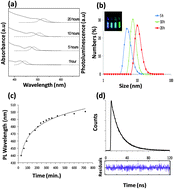Developing a facile method for highly luminescent colloidal CdSxSe1−x ternary nanoalloys†
Abstract
We report a facile method to synthesize highly luminescent colloidal CdSxSe1−x ternary nanoalloys. The synthesis is achieved exactly in one-step, one-pot and at low temperature, by applying the two-phase thermal approach. The optical and structural properties of the nanoalloys were characterized by various techniques. Photoluminescence of the nanoalloys is tunable from 435 to 545 nm by either the size or the composition of the nanoalloys. Highly luminescent nanoalloys having quantum yields up to 90% were prepared. The hydrodynamic size of the nanoalloys can be varied from 1.4 to 10.0 nm by the reaction time. DLS measurements showed that the size distribution of the nanoalloys is monodispersed. TEM images confirmed the size and the size distribution of the nanoalloys. The sulfur fraction in the nanoalloy composition, measured by XRD and verified by EDX, is modulated from 0.17 to 0.95 by increasing the amount of thiourea in the chalcogenide mixture. The sulfur-rich nanoalloys are formed when the initial mole ratio of the chalcogenide (S : Se) is equal or higher than eleven-fold. The gradient and homogeneous internal structures are revealed by analysis of the alloy composition as a function of the growth time. We propose that the two-phase approach, a non-injection technique, is a facile and versatile method to develop highly luminescent CdSxSe1−x nanoalloys without an inorganic coating layer.


 Please wait while we load your content...
Please wait while we load your content...